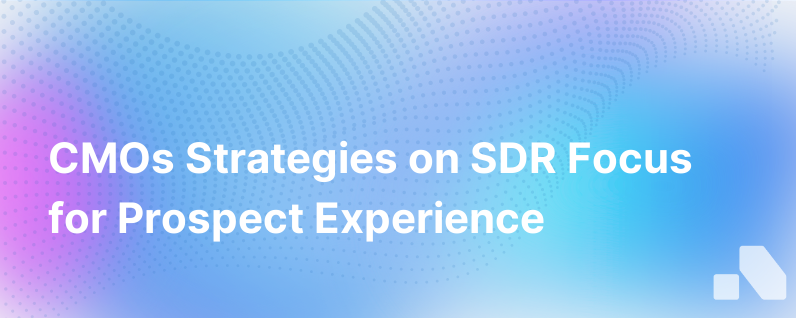Appointment Setting Or New Prospect Experience How Cmos Are Managing Sdr Focus And Strategy
Published on December 7, 2023 by David Zhang
In the ever-evolving landscape of B2B sales, the role of Sales Development Representatives (SDRs) is continuously transforming, particularly when it comes to appointment setting and crafting new prospect experiences. Chief Marketing Officers (CMOs) and sales leaders are now rethinking SDR focus and strategy to better align with today’s buyer’s journey and the pressures of digital transformation.
Appointment setting, traditionally seen as pure cold outreach to book as many meetings as possible, is rapidly changing into an art form of building relationships and providing tailored experiences. This shift signifies a broader change in how SDRs engage with prospects throughout their decision-making process.
The Evolving Role of SDRs SDRs were often used as a filter or buffer between marketing-generated leads and account executives. Their tasks were mainly quantitative, requiring them to reach out to a high volume of leads to set appointments without much consideration for the quality of the engagement.
However, a shift in buyer expectations has pushed CMOs to reassess this strategy. The modern buyer is well-informed, inundated with choices, and desires personalized conversations that are both relevant and valuable. This environment demands an enhanced approach to appointment setting that relies on the quality of interaction rather than the quantity.
Given this backdrop, CMOs and sales leaders are adopting different strategies to train, enable and guide SDR teams. Here are some key areas of focus and strategy management:
1. SDR Training and Development
Forward-thinking organizations are investing heavily in the ongoing training and development of their SDR teams. Customized training modules on industry trends, product knowledge, and understanding client pain points are now foundational to SDR enablement.
Moreover, there's a strong emphasis on soft skills development, such as effective communication, active listening, and empathy. These skills are crucial for SDRs to understand prospects' needs better and create meaningful dialogue, enhancing the prospect experience right from the first interaction.
2. Tailored Engagement
CMOs are promoting the concept of tailored engagement. Modern SDRs are expected to do their homework; they need to understand the prospects' business environment, recent company news, and even the individual role and challenges of their prospect.
Personalized outreach methods include leveraging prospects' preferred channels and providing content that aligns with their specific stage in the buyer journey. This could be industry insights, case studies, or even personalized video messages that address specific pain points.
3. Alignment with Marketing Efforts
Marketing teams spend significant effort in creating content and executing campaigns. Ensuring SDRs are aligned with marketing initiatives is more critical than ever. SDRs need to be in sync with the content and messages being pushed through marketing channels so that there is consistency in the prospect experience.
Regular collaboration and feedback loops between the SDR and marketing teams have become a staple. This intake ensures SDR efforts complement and leverage marketing campaigns, increasing the value of both functions' contributions.
4. Utilizing Technology
In an era of technological advancements, CMOs are tapping into the power of AI and machine learning to enhance SDR productivity and effectiveness. Tools like CRM systems, sales intelligence, and engagement platforms are no longer nice-to-haves but crucial elements in the SDR tech stack.
Platforms like Aomni provide real-time account intelligence and actionable insights which help SDRs personalize conversations, tailor strategic outreach, and save time on research.
5. Quality Over Quantity
Modern appointment setting is not solely about booking a meeting; it's about setting the right meetings. SDR leaders are measuring success in terms of meeting quality and subsequent progression in the sales funnel rather than just the number of meetings set.
SDRs are trained to identify strong-fit prospects and nurture them appropriately, ensuring that the time of sales executives is spent on meetings that have a higher likelihood of advancing through the sales pipeline.
6. Fostering Relationships and Trust
Beyond the immediate goal of securing appointments, SDRs are also encouraged to foster trust and relationships. They are taught to follow up judiciously, maintain engagement, and position themselves as reliable advisors by sharing relevant content and staying engaged throughout the buyer's journey.
7. Continuous Improvement through Data
Data-driven insights help in shaping SDR strategies and workflows. By regularly analyzing performance data, CMOs and sales leaders can better understand what works in their industry and market, and continually refine their SDR teams' approaches to prospecting and appointment setting.
Conclusion The role of SDRs in B2B marketing and sales cannot be overemphasized. They form the frontline of engagement with prospects and play a pivotal role in setting the stage for successful sales relationships.
In the current climate, CMOs and sales leaders are placing a renewed focus on appointment setting and the prospect experience. They are driving SDR strategy toward personalized engagement, training and development, strong alignment with marketing, and intelligent use of technology. The result is an elevated new prospect experience that resonates in today’s highly competitive B2B market.
Sales development is no longer just a numbers game; it's becoming a nuanced process that, with tools like Aomni, is fueling the growth of startups and established businesses alike, building a pipeline of high-quality leads and sustainable revenue.